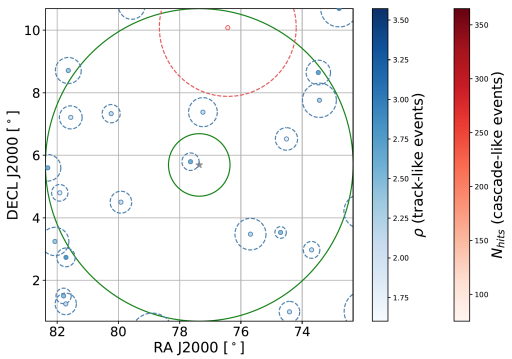
The ANTARES Collaboration thanks the IceCube Collaboration for the sharing of information before the public release. ANTARES congratulates the IceCube Collaboration for what seems to be a new major step forward in the multi-messenger era !

The ANTARES Collaboration thanks the IceCube Collaboration for the sharing of information before the public release. ANTARES congratulates the IceCube Collaboration for what seems to be a new major step forward in the multi-messenger era !
On Wednesday Feb. 12th, the KM3NeT collaboration announced the detection of the highest energy neutrino ever detected, dubbed KM3-230213A, of an energy […]
Today, the LIGO and Virgo collaborations have announced the detection of a new gravitational wave event, GW170817, which constitutes the first time that […]
EN Excerpt from the program The completion of the ANTARES high-energy neutrino telescope in the deep Mediterranean Sea has enabled a […]
January 29th, 2007 Neutrino astronomy in the Mediterranean! On January 29, at dawn, the last of the 3 recently immersed lines […]
| Cookie | Duration | Description |
|---|---|---|
| cookielawinfo-checkbox-analytics | 11 months | This cookie is set by GDPR Cookie Consent plugin. The cookie is used to store the user consent for the cookies in the category "Analytics". |
| cookielawinfo-checkbox-functional | 11 months | The cookie is set by GDPR cookie consent to record the user consent for the cookies in the category "Functional". |
| cookielawinfo-checkbox-necessary | 11 months | This cookie is set by GDPR Cookie Consent plugin. The cookies is used to store the user consent for the cookies in the category "Necessary". |
| cookielawinfo-checkbox-others | 11 months | This cookie is set by GDPR Cookie Consent plugin. The cookie is used to store the user consent for the cookies in the category "Other. |
| cookielawinfo-checkbox-performance | 11 months | This cookie is set by GDPR Cookie Consent plugin. The cookie is used to store the user consent for the cookies in the category "Performance". |
| viewed_cookie_policy | 11 months | The cookie is set by the GDPR Cookie Consent plugin and is used to store whether or not user has consented to the use of cookies. It does not store any personal data. |